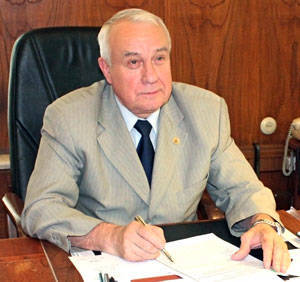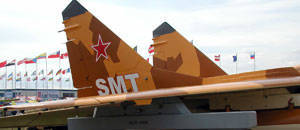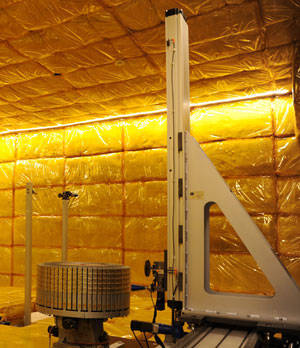EW: yesterday, today, tomorrow
EW in the context of global informatization of armed confrontation is one of the main success factors. This fully applies also to the confrontation of the means of aerospace attack and aerospace defense, in which the state of the electronic warfare of the parties at the beginning of the conflict determines the winner. About stories and the actual tasks of the institute were told by the general director of CNIRTI, doctor of technical sciences, professor Boris Lobanov.
Federal State Unitary Enterprise “TsNIRTI named after Academician A.I. Berg”, which is today part of the Federal Space Agency and is at the origin of the electronic warfare in our country as a science, offers technologies that not only allow to solve current problems in this field, but and lay the foundation for its future development.
In the beginning was the radar
 The Central Research Institute of Radio Engineering named after Academician A.I. Berg (the original name is the All-Union Radiolocation Research Institute, later the famous Scientific Research Institute-108) began its work in the harsh years of the Great Patriotic War and this year celebrated its 70 anniversary. The initiator and the first head of the institute was one of the greatest scientists of his time, engineer and rear admiral Axel Ivanovich Berg, later academician of the USSR Academy of Sciences, admiral engineer, Hero of Socialist Labor. The institute now bears the name of A.I. Berg, and in 2013, the institute celebrates the anniversary date - 120, since the birth of its founder. The purpose of the scientific research institute was the need for a unified scientific and technical center on radiolocation problems, which by that time showed high efficiency in conducting combat operations in various conditions.
The Central Research Institute of Radio Engineering named after Academician A.I. Berg (the original name is the All-Union Radiolocation Research Institute, later the famous Scientific Research Institute-108) began its work in the harsh years of the Great Patriotic War and this year celebrated its 70 anniversary. The initiator and the first head of the institute was one of the greatest scientists of his time, engineer and rear admiral Axel Ivanovich Berg, later academician of the USSR Academy of Sciences, admiral engineer, Hero of Socialist Labor. The institute now bears the name of A.I. Berg, and in 2013, the institute celebrates the anniversary date - 120, since the birth of its founder. The purpose of the scientific research institute was the need for a unified scientific and technical center on radiolocation problems, which by that time showed high efficiency in conducting combat operations in various conditions.In accordance with the tasks entrusted to the institute, since the beginning of 1944, work has begun on various types of radar equipment, radar protection from interference, electronic reconnaissance and radio countermeasures, television equipment, radio wave propagation, electrovacuum and semiconductor devices and other areas.
Electronic warfare
Since the end of the 50-ies, the Central Research Institute of Radio Engineering has been transformed from a radiolocation institute into an institute for combating it. In the 60-ies, in connection with the emergence of the Ministries of the Communications Facilities Industry (IPCC) and the radio engineering industry (MCI), the tasks in the field of EW between these departments were clarified. For enterprises MCI left the task of dealing with radio systems and facilities. This became the main activity of the institute. In 1966, the duties of the head organization of the ministry in the direction of EW are assigned to it and it is called the Central Radio Engineering Research Institute (TsNIRTI).
The idea of creating an electronic warfare in the form of a multi-sensor integrated electronic protection system was formulated at a conceptual level. Along with traditional EW radio equipment, it uses towed detachable traps, spurious targets, and optoelectronic devices integrated into a system controlled by single processor devices. This gave a new impetus to the development of EW facilities at the institute. The creation of basic elements of the electronic protection system began, such as:
When creating basic elements, complex microminiaturization is widely used. A striking example is the development of the DRFM itself. The basis of its development of FSUE “SRITI named after Academician A.I. Berg” became the VLSI 1879ВМ3, which provides the operating frequency band over 500 MHz and incorporates ADC, DAC, arithmetic logic devices (ALU), interfaces. VLSI was created together with the Scientific and Technical Center “Module”.
Perspectives and Innovations
One of the promising trends is the integration of EW air, land, sea and space assets into a single network, which will ensure protection even for a small unit or facility. The concept of integration is based mainly on the development of digital areas of radio intelligence technology and active EW. It is possible to instantly identify the sources of radiation of the enemy and, if necessary, create interference in various ways. This may be the point setting of low-power active interference, the use of objects of false information, such as false targets or messages, the introduction of packages of algorithms that can take command of the enemy’s networks, and possibly the control of their sensors.
 The development of a coherent digital transceiver with the functions of a radiating signal direction finder and the formation of interfering signals will provide the possibility of combining the functions of electronic reconnaissance, radio countermeasures and location in one element and thus solve the problem of detecting and analyzing threats while simultaneously jamming several targets. suppressions and locations. The capabilities of a coherent digital receiver based on digital memory and frequency reproduction technology allow you to simulate target phantoms for an adversary's radar with all the necessary characteristics, features of the “portrait” of the target in terms of reflectivity, motion dynamics, length (geometric dimensions), and spectral characteristics of the object.
The development of a coherent digital transceiver with the functions of a radiating signal direction finder and the formation of interfering signals will provide the possibility of combining the functions of electronic reconnaissance, radio countermeasures and location in one element and thus solve the problem of detecting and analyzing threats while simultaneously jamming several targets. suppressions and locations. The capabilities of a coherent digital receiver based on digital memory and frequency reproduction technology allow you to simulate target phantoms for an adversary's radar with all the necessary characteristics, features of the “portrait” of the target in terms of reflectivity, motion dynamics, length (geometric dimensions), and spectral characteristics of the object.The introduction of digital methods for processing radio-electronic signals allows us to solve the problem of radio-electronic protection of virtually any object of space, air, land or sea-based. An example was the creation of a unified active jamming station MSP-418K for MiG-29 type aircraft and the Omul radio-resistance system for Su-25CM (UBM) and Su-30МК2 aircraft designed for individual and individual mutual protection of aircraft by creating deliberate active interference electronic controls weapons, included in the anti-aircraft missile, anti-aircraft artillery and air defense missile systems. In both stations, the basis for the development is a digital channel coherent transceiver based on the DRFM technology. At operation of stations the specialized testing equipment is not required. The structure of the construction and technical characteristics of the MSP-418K station, implemented on the basis of unified base modules, in particular DRFM, already today ensure their use in other systems, complexes and directions, for example, for solving problems with state recognition, radar systems, for creating simulators and simulators, measuring equipment and systems, telecommunications systems.
 Along with the traditional, new directions of activity, including technologies for reducing visibility and masking, have recently been developed at the institute. These include, for example, the development of new types of radio absorbing materials, including sandwich laminated panels. This dielectric radio absorbing material allows you to effectively absorb electromagnetic waves in a wide range of frequencies and angles of incidence. On its basis, anechoic chambers are created. Upon completion of the construction of the anechoic chamber, the institute's employees, together with the staff of the Main Metrological Scientific Center of the Ministry of Defense of the Russian Federation, develop a program and methodology for the primary certification of the anechoic shielded chamber, carry out the certification itself, check the characteristics of the chamber. After the checks are completed, metrological certificates are issued and the camera is included in the registry of the Ministry of Defense of the Russian Federation. At the request of the customer, voluntary certification in Rostest is possible with the subsequent inclusion of the product into the register of anechoic chambers of federal significance.
Along with the traditional, new directions of activity, including technologies for reducing visibility and masking, have recently been developed at the institute. These include, for example, the development of new types of radio absorbing materials, including sandwich laminated panels. This dielectric radio absorbing material allows you to effectively absorb electromagnetic waves in a wide range of frequencies and angles of incidence. On its basis, anechoic chambers are created. Upon completion of the construction of the anechoic chamber, the institute's employees, together with the staff of the Main Metrological Scientific Center of the Ministry of Defense of the Russian Federation, develop a program and methodology for the primary certification of the anechoic shielded chamber, carry out the certification itself, check the characteristics of the chamber. After the checks are completed, metrological certificates are issued and the camera is included in the registry of the Ministry of Defense of the Russian Federation. At the request of the customer, voluntary certification in Rostest is possible with the subsequent inclusion of the product into the register of anechoic chambers of federal significance.The second type of radio absorbing materials is space-distributed spatial formations (ORPO) based on aerosol mixtures with nanotubular hydrocarbon fillers. This technology was developed within the framework of the Federal Program for Basic Technologies and protects the object from electromagnetic radiation, including that created on new physical principles. The purpose is to reduce the visibility of marine, terrestrial, airborne and space technology using a cloud or a coating of micro and nanoscale threadlike structures that absorb electromagnetic radiation in a wide frequency range.
At present, a large cooperation of well-known in the country enterprises specializing both in the field of electronic warfare and other technical areas of industry has been involved in the work of our institute. We invite everyone to get acquainted with the exposition of the Federal State Unitary Enterprise “Scientific Research Engineering Institute named after Academician A.I. Berg” at the 11-th International Aviation and Space Salon “MAKS-2013”.
Information